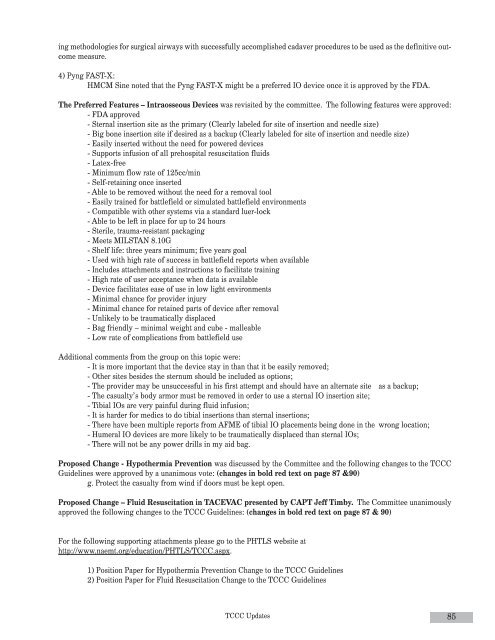Fall - United States Special Operations Command
Fall - United States Special Operations Command
Fall - United States Special Operations Command
You also want an ePaper? Increase the reach of your titles
YUMPU automatically turns print PDFs into web optimized ePapers that Google loves.
ing methodologies for surgical airways with successfully accomplished cadaver procedures to be used as the definitive outcome<br />
measure.<br />
4) Pyng FAST-X:<br />
HMCM Sine noted that the Pyng FAST-X might be a preferred IO device once it is approved by the FDA.<br />
The Preferred Features – Intraosseous Devices was revisited by the committee. The following features were approved:<br />
- FDA approved<br />
- Sternal insertion site as the primary (Clearly labeled for site of insertion and needle size)<br />
- Big bone insertion site if desired as a backup (Clearly labeled for site of insertion and needle size)<br />
- Easily inserted without the need for powered devices<br />
- Supports infusion of all prehospital resuscitation fluids<br />
- Latex-free<br />
- Minimum flow rate of 125cc/min<br />
- Self-retaining once inserted<br />
- Able to be removed without the need for a removal tool<br />
- Easily trained for battlefield or simulated battlefield environments<br />
- Compatible with other systems via a standard luer-lock<br />
- Able to be left in place for up to 24 hours<br />
- Sterile, trauma-resistant packaging<br />
- Meets MILSTAN 8.10G<br />
- Shelf life: three years minimum; five years goal<br />
- Used with high rate of success in battlefield reports when available<br />
- Includes attachments and instructions to facilitate training<br />
- High rate of user acceptance when data is available<br />
- Device facilitates ease of use in low light environments<br />
- Minimal chance for provider injury<br />
- Minimal chance for retained parts of device after removal<br />
- Unlikely to be traumatically displaced<br />
- Bag friendly – minimal weight and cube - malleable<br />
- Low rate of complications from battlefield use<br />
Additional comments from the group on this topic were:<br />
- It is more important that the device stay in than that it be easily removed;<br />
- Other sites besides the sternum should be included as options;<br />
- The provider may be unsuccessful in his first attempt and should have an alternate site as a backup;<br />
- The casualty’s body armor must be removed in order to use a sternal IO insertion site;<br />
- Tibial IOs are very painful during fluid infusion;<br />
- It is harder for medics to do tibial insertions than sternal insertions;<br />
- There have been multiple reports from AFME of tibial IO placements being done in the wrong location;<br />
- Humeral IO devices are more likely to be traumatically displaced than sternal IOs;<br />
- There will not be any power drills in my aid bag.<br />
Proposed Change - Hypothermia Prevention was discussed by the Committee and the following changes to the TCCC<br />
Guidelines were approved by a unanimous vote: (changes in bold red text on page 87 &90)<br />
g. Protect the casualty from wind if doors must be kept open.<br />
Proposed Change – Fluid Resuscitation in TACEVAC presented by CAPT Jeff Timby. The Committee unanimously<br />
approved the following changes to the TCCC Guidelines: (changes in bold red text on page 87 & 90)<br />
For the following supporting attachments please go to the PHTLS website at<br />
http://www.naemt.org/education/PHTLS/TCCC.aspx.<br />
1) Position Paper for Hypothermia Prevention Change to the TCCC Guidelines<br />
2) Position Paper for Fluid Resuscitation Change to the TCCC Guidelines<br />
TCCC Updates 85

















